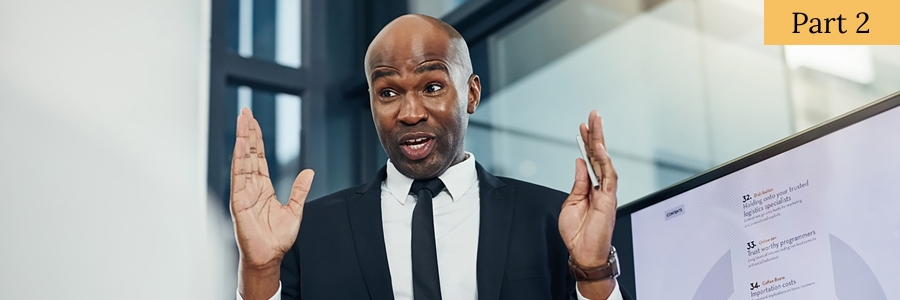
Read or listen to this article.
Whoa! Did we ever get a response to our previous article, “How to Brief Senior Leaders and Make It Count”! You can read it or listen to it here.
We received some excellent comments on the web page, but we also got lots of direct responses—mostly from senior leaders who have distinct views on how to brief senior leaders. These readers also added their thoughts on how Big Bosses ought to instruct their juniors to help them put their best brief forward every time.
Their advice on both topics was so good we had to share it with you. So, here it is, Part 2 of "How to Brief Senior Leaders and Make it Count."
Setting Your Brief Up for Success
Our previous article talked about how crucial it is for a briefer to define the purpose of the brief—determining the "home run" that will give the senior executive what they need—and gathering the intel to understand how best to deliver it.
Toward that end, our readers added five more suggestions for briefers:
- First, pay attention to what your audience would prize from your brief. This will take both digging and deep thought. Especially, identify what one senior leader calls "the essence of the issue." That’s the one that will matter to the boss, the one that gets to the real, real subject at hand.
- Second, understand the importance of knowing the people who will be in the room, aside from the boss. “In the military, if there is a 3-star taking the meeting as the decision-maker, then there will be several 1- and 2-stars around the table,” one reader explained. (For the rest of us, imagine a CEO with EVPs and VPs at the table. The dynamics are pretty similar.) “Sometimes an ally who is not part of your immediate organization can carry the tide of victory for your pitch.” (We might add that those potential allies can sometimes help you learn—or infer—that essence of the issue we just mentioned.)
- Third, coordinate closely. If anyone is presenting alongside you, as when there are back-to-back briefs, make sure your stories mesh, as appropriate. One reader noted, “In the case of multiple briefers, they often fail to sync messages, instead forcing the leader to synthesize their information.”
- Fourth, ask about the boss’ “tells,” carefully. One reader liked our suggestion about talking to the boss’ executive assistant to gather intel on the boss’ style, but then he added this useful tweak: “Ask about the boss’s ‘tells’ last, so you don’t sound like you’re trying to wheedle information from a subordinate.”
- Lastly, look out for this peevish landmine. When learning about the boss’s interests, concerns, and annoyances, one reader advised, “Know that it’s not unusual for a senior to have a deeply seated peeve, one that can bring the whole endeavor to a halt if you violate it.”
Building the Brief
Simplicity. That was the theme of most of the senior leaders’ comments on building the brief. That’s about making it simple, but not simplistic.
So this doesn’t mean dumbing down the presentation—just the opposite. Making a briefing simple but useful requires careful thinking to pinpoint what the senior leader really needs and the most effective, concise way to present it.
Here are some of those leaders’ suggestions on this topic:
- Don’t waste time in the weeds. One reader explained: “Bombarding a senior leader with a mega-slide brief to cover every possible angle of the topic and demonstrate your mastery of the subject matter only serves to show you don’t know what is REALLY important.” Another reader put it this way: “If the ‘big guy or gal’ needs only to know what time it is, don’t try to tell them how to make a clock.”
- Make the math clear and impactful. Statistics and large numbers can be hard to grasp quickly or intuitively, so one reader suggested using the tools in the book Making Numbers Count by Chip Heath and Karla Starr. Here’s a great example: “We know there’s a lot of water on this planet, but understanding how much of it we can drink is hard to conceive. Heath and Starr tell us to visualize a gallon jug of water and next to it three ice cubes; the jug is all the salt water; the ice cubes are all the fresh water, and what drips off the ice cubes is all the water we can access to drink. Wow.” (Since receiving this recommendation, we’ve read that book, and we agree.)
- Stressed or inundated audiences absorb less. Humans can process only so much information, and the higher the level of stress/crisis, the less they can take in. One reader said, “Many briefers fail to take into account the number of things a decision leader needs to absorb to make a decision—and things they don’t need.”
- Keep your slides clear and concise. If there’s so much data in one place that no one can see it, let alone understand it, you’ll just annoy your audience. One reader advised, “Less is more, and pictures are infinitely better than words!” (We’re pretty sure they’re not suggesting clipart.)
In addition to those four points on making the brief simple but not simplistic, here are some additional tips from readers’ on getting your presentation together:
- Abandon the Golden Rule. One reader told us, “The mistake I see most is briefers assembling and giving the brief they would give themselves… without any thought to who the audience is.” So, at least for the purposes of building the brief, treat briefees as they want to be treated. Remember that you’re briefing a person with unique needs and perspectives, and not just a crankier version of yourself.
- Supply supporting data, but also supply motivation. One reader explained: “Briefs for seniors are, by definition, decision briefs. However, decisions are premised on both objective facts and subjective commitment. So a good brief aims both to inform and convince; it stimulates both reason and conviction.”
- Don’t over-rely on anecdotes. A relevant story can help to illustrate a point. But don’t mistake anecdotes for real data, as one reader advised. He then he added: “Your personal anecdotes may be of excruciatingly little interest.”
- Work within the template constraints given. If the senior leader has dictated a set format, then use it. Don’t stray too far from the maximum number of slides, maximum number of bullets per slide, minimum type size, or any other instructions you’ve been given. (Most of the leaders who wrote us didn’t have much enthusiasm for those kind of formatting limitations on briefs, but then again, they’re probably not your boss.)
- Don’t ever read your slides to the audience; they can do that themselves. And consider yourself warned: Most of the people who wrote in with this advice put it in all caps.
In the Room
Senior leaders sent in more great ideas for mastering the room and wrapping things up:
- Get to the point right away. Remind your audience why they’re there, and then keep your remarks short and concise. “But be ready with additional details if discussion or questions occur,” one senior leader advised. “This facilitates leadership team discussion.”
- Spark discussion; don’t avoid it. If you’re reading the room and notice that it’s gotten uncomfortably quiet, try asking a question that will spark discussion. One reader commented: “Asking for feedback during a brief helps the exchange of ideas flow, making rapport lots easier to establish.” Another added, “If the room permits, you should walk around and talk. … For me this just makes everything work so much better!”
- Never try to fake your way through a question. As one reader noted, the executive asking a question might already know the answer, and you don’t want to get caught BS-ing.
- Don’t be afraid to end early. Just because you’ve been given a window of time for your presentation doesn’t mean you need to use it all. “We often fill space because space is given,” one reader commented, but no one will penalize you for a productive briefing that finishes ahead of schedule.
- Have someone take notes. Obviously, do that if it’s permissible in your role. Those notes should be distributed shortly after the meeting, and they should include “action items, responsible parties, and due dates,” according to one reader.
How Senior Leaders Can Foster Better Briefings
Our readers had some companion advice for fellow briefees to help them get the results they’re looking for. Here are some of their recommendations on consistently getting good briefings:
- Provide a thoughtful template. You don’t want to lock your subordinates into a rigid structure that dictates every detail of the presentation. That’s because, as one reader noted, it’s hard to tell a story that way. But if you want them to spell out the needed decision upfront and provide their best recommendations at the end, then you should definitely bookend your template with those two slides.
- Or … discourage the slides, if you find them unhelpful. One reader told us, “I specify that PowerPoint be used only to present quantifiable data or a scene-setter such as a map or a chart of data—absent lightning bolts, clouds of words, exclamation points, etc.”
- Require read-aheads that work for you. One of our readers – the one who’s not keen on gratuitous PowerPoint adornments – apparently doesn’t like wading through fluff in his overnight reading, either. So that leader specifies that pre-reads be “one to two pages (single spaced) of nothing smaller than 12-point type, usually lacking in adverbs or adjectives.” That may be too prescriptive for you, or not enough. But if you’ve already learned what works for you and what doesn’t, then spell it out for the briefer.
- Reward great read-aheads. If the pre-read you received really worked for you then, in the meeting, be sure to say a kind word, articulating what you liked – so that the briefer and others will catch on. Alternatively, one of our readers may have come up with the ultimate reward for great read-aheads. That person noted, if the read-ahead is good enough and no further discussion is required, you can give your staff—and yourself—the gift of canceling the briefing entirely.
- Focus on the essence of the issue. Remember how important it is for briefers to be able to define the essence of the issue? If you’re the briefee, you need to be able to focus on that essence, too. So consider requiring that essence to be called out in the read-ahead.
- Set the tone for the meeting. Here’s another great use for the read-ahead: Spend the first few minutes of the briefing giving your commentary on or asking questions about what you’ve already learned. Then, after your staff has filled in the gaps and gone through their spiel, take the last few minutes as well to let them know your decision or the next steps.
Parting Advice
How to brief senior leaders is a fascinating topic, isn’t it? For years, it was an optional “bonus segment” of a masters-level strategic planning course we conducted at the Naval Postgraduate School in Monterey, California. The room was always packed.
To come up a level, we’d say the overarching theme from the dozen or so senior leaders who wrote to us is one of pragmatic empathy—something else we discuss in our leadership classes. In other words, briefer and briefee must each work to help the other get what they need to succeed. That’s not always easy, and it requires special effort when the briefer is layers below the person being briefed, or is siloes away, or is from a completely different organization (as is true for ELG’s consultants when we brief senior leaders).
Here’s our parting advice:
- If you’re the person who briefs senior leaders, you might review the points in both articles and then make your own checklist, one that suits you and your situation best. And then return to that list every time you’re assigned a brief, at least for a while. You’ll find that your own personalized checklist is a great thinking and learning tool. And, anytime you can learn something about how to deal with senior leaders—and not learn it the hard way—you’re coming out ahead.
- If you’re a recipient of briefs, you could print the articles, highlight the parts you agree with, cross out the parts you don’t, and give them to your briefers. Or you could use them as a starting point for writing your own guidance: “How to Brief Me.” (If you do that, please send us a copy! We’ll reciprocate by sending you an official ELG Grail of Accountability … which doubles as a coffee mug.)
Any of these approaches produces a win-win: Briefers receive invaluable coaching that will help deliver the right message the best way, briefees get the input they need, and everyone gets a higher ROI on the time they spend in the briefing room.


Lucas Sheehan
Fantastic follow up to an already excellent Part 1.
Bill Casey
Lucas,
Thank you! Much appreciated!